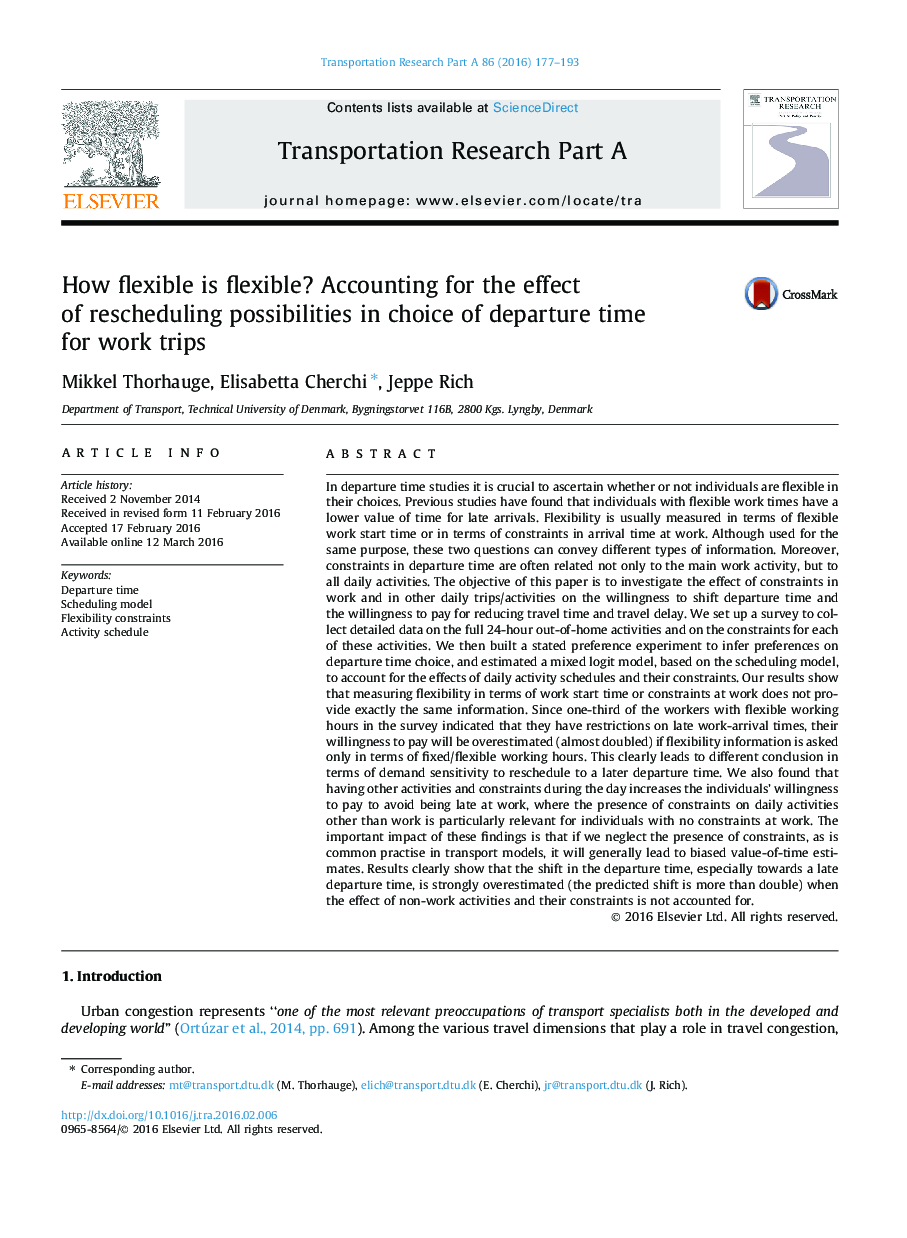| کد مقاله | کد نشریه | سال انتشار | مقاله انگلیسی | نسخه تمام متن |
|---|---|---|---|---|
| 6780961 | 533328 | 2016 | 17 صفحه PDF | دانلود رایگان |
عنوان انگلیسی مقاله ISI
How flexible is flexible? Accounting for the effect of rescheduling possibilities in choice of departure time for work trips
ترجمه فارسی عنوان
چقدر انعطاف پذیر است؟ حسابداری برای تأثیر فرصت های بازنشستگی در انتخاب زمان خروج برای سفرهای کاری
دانلود مقاله + سفارش ترجمه
دانلود مقاله ISI انگلیسی
رایگان برای ایرانیان
کلمات کلیدی
زمان خروج، مدل زمانبندی محدودیت های انعطاف پذیر، برنامه فعالیت
ترجمه چکیده
در مطالعات زمان خروج، تعیین اینکه آیا افراد در انتخاب خود انعطاف پذیر هستند، بسیار مهم است. مطالعات قبلی نشان داده است افرادی که دارای کار انعطاف پذیری هستند، زمان کمتری برای زمان ورود به اواخر دارند. انعطاف پذیری معمولا با توجه به زمان شروع کار انعطاف پذیر یا از نظر محدودیت در زمان ورود در محل کار اندازه گیری می شود. اگر چه برای همین هدف مورد استفاده قرار می گیرد، این دو سؤال می توانند انواع مختلفی از اطلاعات را انتقال دهند. علاوه بر این، محدودیت ها در زمان خروج اغلب مربوط به فعالیت اصلی کار، اما به تمام فعالیت های روزمره است. هدف این مقاله، بررسی تأثیر محدودیت ها در کار و دیگر سفرهای روزانه / فعالیت های مربوط به تمایل به تغییر زمان خروج و تمایل به پرداخت هزینه برای کاهش زمان سفر و تاخیر سفر است. ما یک نظرسنجی را برای جمع آوری اطلاعات دقیق در فعالیت های 24 ساعته خارج از منزل و محدودیت های هر یک از این فعالیت ها ایجاد کردیم. سپس یک آزمایش اولویت اظهار کردیم تا ترجیحات را در انتخاب زمان خروج به ارمغان بیاوریم و یک مدل منطقی مخلوط بر اساس مدل برنامه ریزی را برای تخمین تأثیر برنامه های روزانه فعالیت و محدودیت های آنها محاسبه کردیم. نتایج ما نشان می دهد که اندازه گیری انعطاف پذیری از لحاظ زمان شروع کار یا محدودیت در کار دقیقا مشابه اطلاعات ارائه نمی دهد. از آنجایی که یک سوم کارگران با ساعت کار انعطاف پذیر در نظرسنجی نشان دادند که محدودیت های مربوط به زمان ورود به اواخر کار است، تمایل آنها به پرداخت بیش از حد (تقریبا دو برابر می شود)، اگر اطلاعات انعطاف پذیری فقط از نظر کار ثابت / انعطاف پذیر ساعت ها. این به وضوح منجر به نتیجه گیری متفاوت از لحاظ حساسیت تقاضا برای تعویض به زمان خروج بعدی می شود. همچنین ما دریافتیم که داشتن فعالیت ها و محدودیت های دیگر در طول روز باعث افزایش تمایل افراد به پرداخت هزینه برای جلوگیری از دیر شدن در کار می شود، در حالی که محدودیت های موجود در فعالیت های روزانه غیر از کار به ویژه برای افراد بدون محدودیت در کار مرتبط است. تأثیر مهم این یافته ها این است که اگر ما محدودیت ها را نادیده بگیریم، همانطور که در مدل های حمل و نقل معمول است، به طور کلی منجر به برآورد ارزش زمان می شود. نتایج به وضوح نشان می دهد که تغییر در زمان خروج، به ویژه در مورد زمان اواخر اواخر، به شدت بیش از حد (تغییر پیش بینی بیش از دو برابر) زمانی که اثر فعالیت های غیر کار و محدودیت های آنها به حساب نمی آید.
موضوعات مرتبط
مهندسی و علوم پایه
سایر رشته های مهندسی
مهندسی عمران و سازه
چکیده انگلیسی
In departure time studies it is crucial to ascertain whether or not individuals are flexible in their choices. Previous studies have found that individuals with flexible work times have a lower value of time for late arrivals. Flexibility is usually measured in terms of flexible work start time or in terms of constraints in arrival time at work. Although used for the same purpose, these two questions can convey different types of information. Moreover, constraints in departure time are often related not only to the main work activity, but to all daily activities. The objective of this paper is to investigate the effect of constraints in work and in other daily trips/activities on the willingness to shift departure time and the willingness to pay for reducing travel time and travel delay. We set up a survey to collect detailed data on the full 24-hour out-of-home activities and on the constraints for each of these activities. We then built a stated preference experiment to infer preferences on departure time choice, and estimated a mixed logit model, based on the scheduling model, to account for the effects of daily activity schedules and their constraints. Our results show that measuring flexibility in terms of work start time or constraints at work does not provide exactly the same information. Since one-third of the workers with flexible working hours in the survey indicated that they have restrictions on late work-arrival times, their willingness to pay will be overestimated (almost doubled) if flexibility information is asked only in terms of fixed/flexible working hours. This clearly leads to different conclusion in terms of demand sensitivity to reschedule to a later departure time. We also found that having other activities and constraints during the day increases the individuals' willingness to pay to avoid being late at work, where the presence of constraints on daily activities other than work is particularly relevant for individuals with no constraints at work. The important impact of these findings is that if we neglect the presence of constraints, as is common practise in transport models, it will generally lead to biased value-of-time estimates. Results clearly show that the shift in the departure time, especially towards a late departure time, is strongly overestimated (the predicted shift is more than double) when the effect of non-work activities and their constraints is not accounted for.
ناشر
Database: Elsevier - ScienceDirect (ساینس دایرکت)
Journal: Transportation Research Part A: Policy and Practice - Volume 86, April 2016, Pages 177-193
Journal: Transportation Research Part A: Policy and Practice - Volume 86, April 2016, Pages 177-193
نویسندگان
Mikkel Thorhauge, Elisabetta Cherchi, Jeppe Rich,
